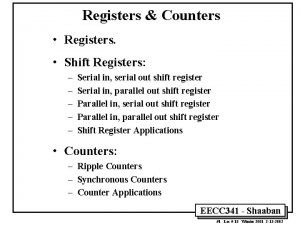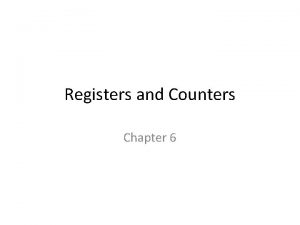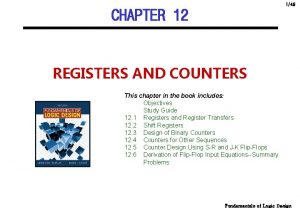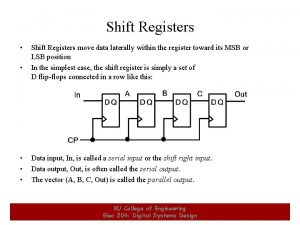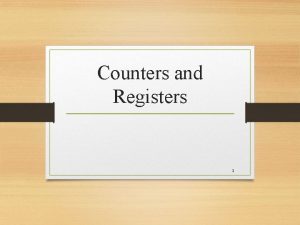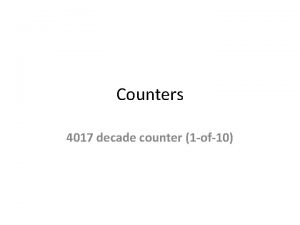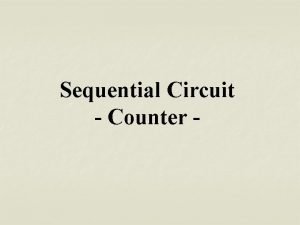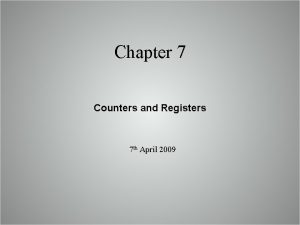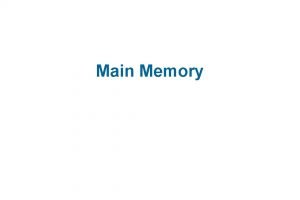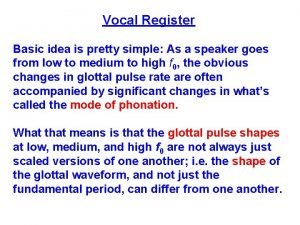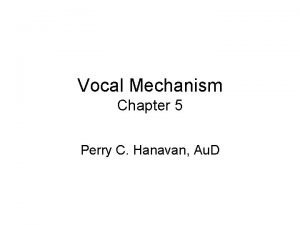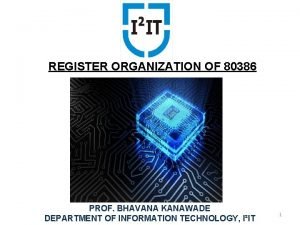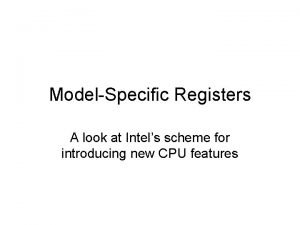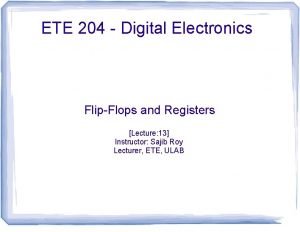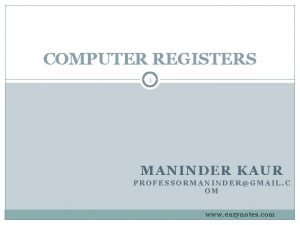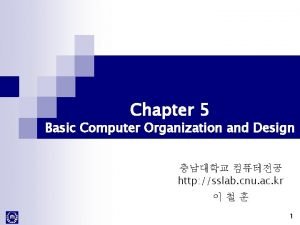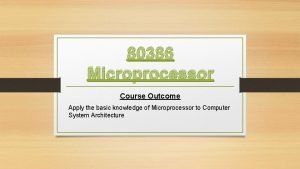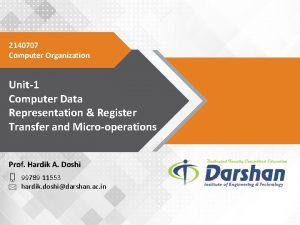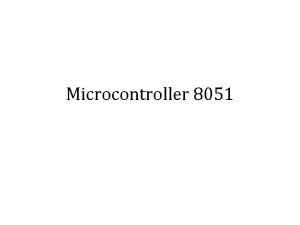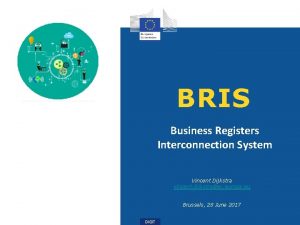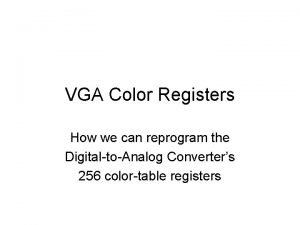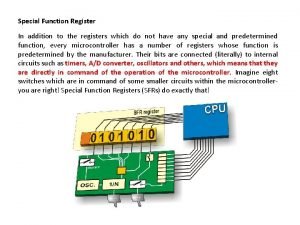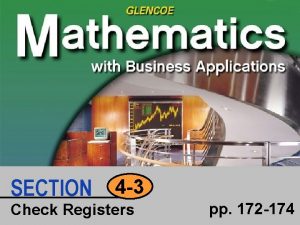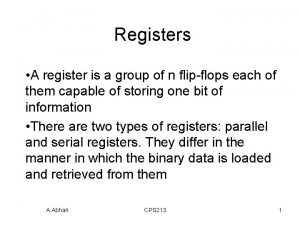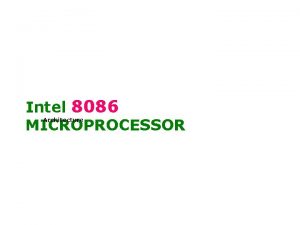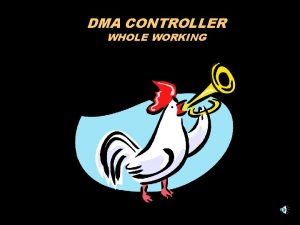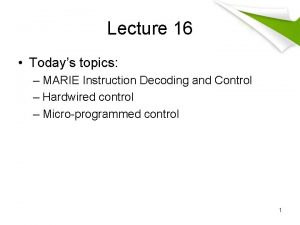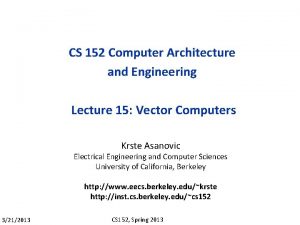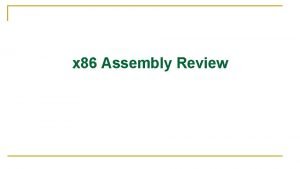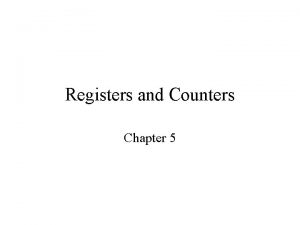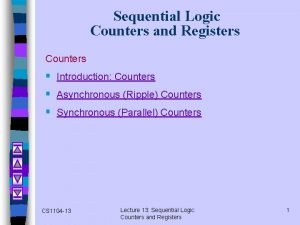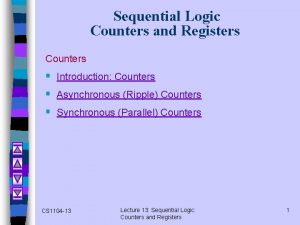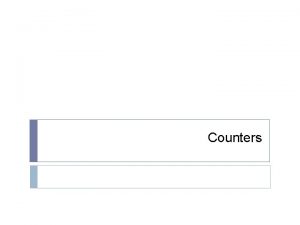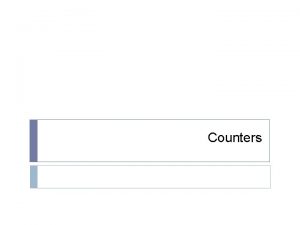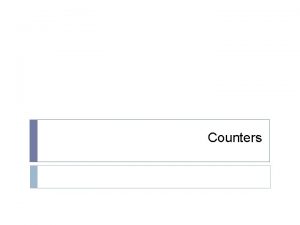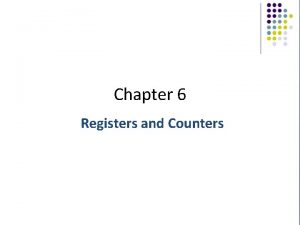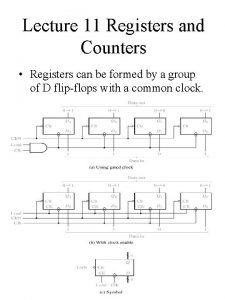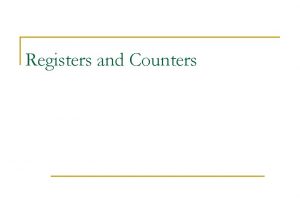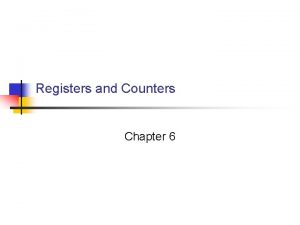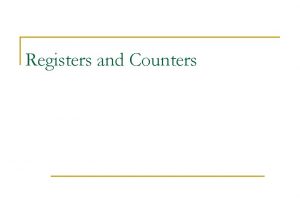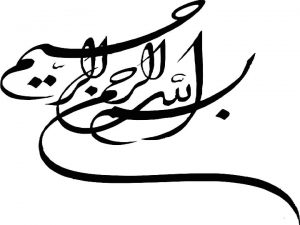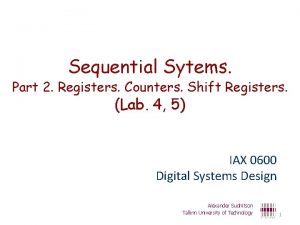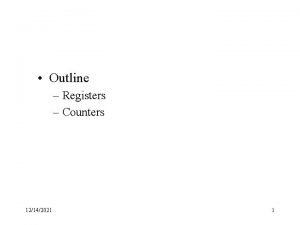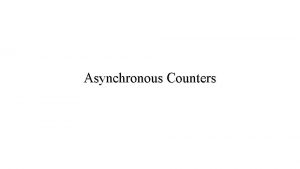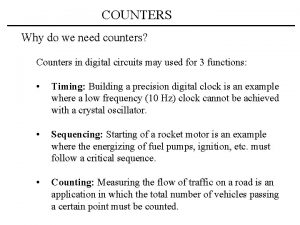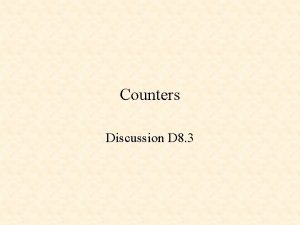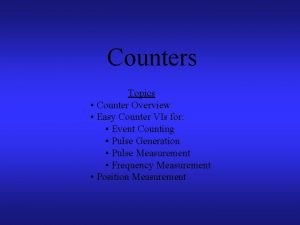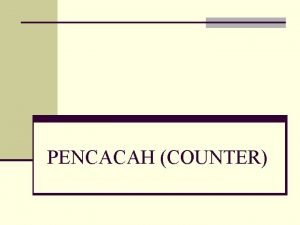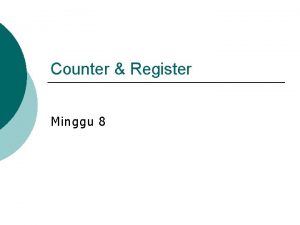Counters and Registers 1 Counters A counter circuit





































- Slides: 37

Counters and Registers 1

Counters • A counter circuit is a sequential logic circuit used to count number of clock pulses received. • Counters are constructed by a number of Flip- flops connected in cascade. • Counters are a very widely used component in digital circuits , and are manufactured as separate ICs and also incorporated as parts of larger integrated circuits. 241 -208 CH 9 2

Classification • Asynchronous (ripple) counter – changing state bits are used as clocks to subsequent state flip-flops • Synchronous counter – all state bits change under control of a single clock (All F/F change state simultaneously) • Decade counter – counts through ten states per stage • Up/down counter – counts both up and down, under command of a control input • Ring counter – formed by a shift register with feedback connection in a ring • Johnson counter – a twisted ring counter • Cascaded counter and • Modulus counter. 3

Assignment 2 • Working of a 4 bit ripple counter and Up/Dn counter • Synchronous counter design using T F/F for the following states 0 8 12 14 15 7 3 1 0 241 -208 CH 9 4

BCD Counter State Diagram 241 -208 CH 9 5

• A decade counter has four flip-flops and 16 potential states, of which only 10 are used and if we connected a series of counters together we could counter to 100 or 1, 000 or what ever number we wanted. • The total number of counts that a counter can count too is called its MODULUS. A counter that returns to zero after n counts is called a modulo-n counter, for example a modulo-8 (MOD-8), or modulo-16 (MOD 16) counter, etc, and for an “n-bit counter”, the full range of the count is from 0 to 2 n - 1 241 -208 6

BCD • Count sequence from 0000 (“ 0”) through to 1001 (“ 9”) is called a binary-coded-decimal counter or BCD Counter or MOD-10 counter can be constructed using a minimum of four toggle flip-flops. 241 -208 CH 9 7

The 74 LS 90 BCD Counter • The 74 LS 90 integrated circuit is basically a MOD 10 decade counter that produces a BCD output code. • The 74 LS 90 consists of four master-slave JK flipflops internally connected to provide a MOD-2 (count-to-2) counter and a MOD-5 (count-to-5) counter. • The 74 LS 90 has one independent toggle JK flipflop ( 2) driven by the CLK A input and three 241 -208 CH 9 8 toggle JK flip-flops that form an asynchronous counter ( 5) driven by the CLK B input as

241 -208 CH 9 9

7490 241 -208 CH 9 10

• The 74 LS 90 counter consists of a divide-by-2 counter and a divide-by-5 counter within the same package. • We can use either counter to produce a divide-by-2 frequency counter only, a divide-by-5 frequency counter only or the two together to produce our desired divide-by 10 BCD counter. 241 -208 CH 9 11

2 counter With the four flip-flops making up the divide-by-5 counter section disabled, if a clock signal is applied to input pin 14 (CLKA) and the output taken from pin 12 (QA), we can produce a standard divideby-2 binary counter for use in frequency dividing circuits as 241 -208 CH 9 12 shown.

5 counter 241 -208 CH 9 13

10 Counter • To produce a divide-by-10 BCD decade counter, both internal counter circuits are used giving a 2 times 5 divide -by value. Since the first output QA from flip-flop A is not internally connected to the succeeding stages, the counter can be extended to form a 4 -bit BCD counter by connecting this QA output to the CLKB input as shown. 241 -208 CH 9 14

Decoder Driver 241 -208 CH 9 15

4 -bit BCD Counter Circuit 241 -208 CH 9 16

Application of counters • • • Frequency counters Digital clock Time measurement A to D converter Frequency divider circuits Digital triangular wave generator. 241 -208 CH 9 17

Shift Registers • Shift registers are a type of sequential logic circuit, • • mainly for storage of digital data. ( 0 s and 1 s) To store a single bit one F/F is required. To store n bits of information n F/F are required They are a group of flip-flops connected in a chain so that the output from one flip-flop becomes the input of the next flip-flop. All the flip-flops are driven by a common clock, and all are set or reset simultaneously.

Types • • • Serial In/Serial Out Shift Registers Serial In/Parallel Out Shift Registers Parallel In/Serial Out Shift Registers Parallel Out/Parallel Out Shift Registers Bidirectional Shift Registers Special Shift Counters Ring Counters and Johnson Counter 241 -208 CH 9 19

Basic Shift Register Functions • A shift register is an arrangement of flip-flops with important applications in storage and movement of data. Data in Data out Serial in/shift right/serial out Data in Serial in/shift left/serial out Parallel in/serial out Data in Data out Serial in/parallel out Data out Parallel in/parallel out Rotate right Rotate left 20

Serial-in/Serial out Shift Register • 5 -bit serial in/serial out shift register implemented with D flip-flops. 1 1 1 CLK 241 -208 CH 9 21

Serial In/Parallel Out Shift Registers • 4 -bit serial in/parallel out shift register • For example, assume the binary number 1011 is loaded sequentially, one bit at each clock pulse. CLK 241 -208 CH 9 22

The 74 HC 164 A Shift Register • 8 -bit serial in/parallel out shift register • One of the two serial data inputs may be used as an active HIGH enable to gate the other input. • If no enable is needed, the other serial input can be connected to Vcc. • The 74 HC 164 A has an active LOW asynchronous clear. • Data is entered on the leading-edge of the clock. CLR CLK Serial A inputs B Q 0 Q 1 Q 2 Q 3 Q 4 Q 5 Q 6 Q 7 23

Parallel In/Serial Out Shift Registers • Shift registers can be used to convert parallel data to serial form. D 0 D 2 D 1 D 3 SHIFT/LOAD Q 0 Q 1 Q 2 Serial Q 3 data out 24 CLK

The 74 HC 165 Shift Register • 8 -bit parallel in/serial out shift register • The clock (CLK) and clock inhibit (CLK INH) lines are connected to a common OR gate, so either of these inputs can be used as an active-LOW clock enable with the other as the clock input. • Data is loaded asynchronously when SH/LD is LOW and moved through the register synchronously when SH/LD is HIGH and a rising clock pulse occurs. D 0 D 1 D 2 D 3 D 4 D 5 D 6 D 7 SH/LD SER CLK INH CLK Q 7 25

Parallel In/Parallel Out Shift Registers 241 -208 CH 9 26

Bidirectional Shift Register § Bidirectional shift registers can shift the data in either direction using a RIGHT/LEFT input. 241 -208 CH 9 27

Shift Register Counters § Shift registers can form useful counters by recirculating a pattern of 0’s and 1’s. Two important shift register counters are the Johnson counter and the ring counter. § The Ring counter and Johnson counter can be made with a series of either D flip-flops or J-K flip-flops. 241 -208 CH 9 28

Ring Counter § § The ring counter can also be implemented with either D flip-flops or J-K flip-flops. 4 -bit ring counters are constructed from a series of D flip -flops J-K flip-flops. Notice the feedback. Initial status after clear and Preset Q 0 Q 1 Q 2 Q 3 0 0 0 1 29

Ring Counter § A common pattern for a ring counter is to load it with a single 1 or a single 0. § Draw the waveforms for the 4 -bit ring counter ( shown in the previous slide) 241 -208 CH 9 30

Johnson counter § The Johnson counter is useful when you need a sequence that changes by only one bit at a time but it has a limited number of states (2 n, where n = number of stages). The first five counts for a 4 -bit Johnson counter that is initially cleared are: CLK Q 0 Q 1 Q 2 Q 3 What are the remaining 3 states? 0 1 2 3 4 5 6 7 0 1 1 1 1 0 0 0 0 0 1 1 31

A Johnson counter is also known as switch-tail ring counter, twisted ring counter, walking ring counter, or Möbius counter. It is a modified ring counter, where the output from the last stage is inverted and fed back as input to the first stage. The register cycles through a sequence of bitpatterns, whose length is equal to twice the length of the shift register, continuing indefinitely. These counters are useful in digital-to-analog conversion, generating control signals etc.

In order to follow an ideal sequence of states both the Ring and the Johnson counter must initially be forced into a valid state in the count sequence using preset and clear inputs. 241 -208 CH 9 33

Shift Register Applications § Examples: Time Delay, Parallel/Serial Data Converter, and Keyboard Encoder An 8 -bit serial in/serial out shift register has a 40 MHz clock. What is the total delay through the register? The delay for each clock is 1/40 MHz = 25 ns The total delay is 8 x 25 ns = 200 ns 34

Serial data transfer • One application of shift registers is converting between “serial data” and “parallel data” • Computers typically work with multiple-bit quantities • ASCII text characters are 8 bits long • Integers, single-precision floating-point numbers, and screen pixels are up to 32 bits long • But sometimes it’s necessary to send or receive data serially, or one bit at a time. Some examples include: • Input devices such as keyboards and mice • Output devices like printers • Any serial port, USB or Firewire device transfers data 35 serially

Receiving serial data serial device • To receive serial data using a shift register: • • computer The serial device is connected to the register’s SI input The shift register outputs Q 3 -Q 0 are connected to the computer • The serial device transmits one bit of data per clock cycle • • These bits go into the SI input of the shift register After four clock cycles, the shift register will hold a four-bit word • The computer then reads all four bits at once from the Q 3 -Q 0 outputs. 36

Sending data serially computer serial device • To send data serially with a shift register, • The CPU is connected to the register’s D inputs • The shift output (Q 3 in this case) is connected to the serial device • The computer first stores a four-bit word in the register, in one cycle • The serial device can then read the shift output • One bit appears on Q 3 on each clock cycle 37 • After four cycles, the entire four-bit word will have been sent
 Counters and shift registers
Counters and shift registers Counters shift registers
Counters shift registers Registers and counters
Registers and counters Counters shift registers
Counters shift registers Counters shift registers
Counters shift registers 4017 decade counter
4017 decade counter State diagram
State diagram 16 bit counter circuit
16 bit counter circuit Mod-10 counter
Mod-10 counter Binary storage register
Binary storage register Hardware address protection with base and limit registers
Hardware address protection with base and limit registers Complete and incomplete circuit diagram
Complete and incomplete circuit diagram Klews chart
Klews chart Circulatory system diagram
Circulatory system diagram Range of the clarinet
Range of the clarinet Vocal registers
Vocal registers Kim kardashian
Kim kardashian Flag register in 80386
Flag register in 80386 Model specific register
Model specific register Hmis forms
Hmis forms In digital electronics
In digital electronics Registers in computer
Registers in computer Design of accumulator logic
Design of accumulator logic Write features of 80386
Write features of 80386 Common bus system for 4 registers
Common bus system for 4 registers 8051 register bank
8051 register bank Business registers interconnection system
Business registers interconnection system Vga registers programming
Vga registers programming Special function registers
Special function registers Section 4-3 check registers
Section 4-3 check registers A register is a group of
A register is a group of Offset in microprocessor
Offset in microprocessor 8237 dma controller pin diagram
8237 dma controller pin diagram Instruction
Instruction Vector registers
Vector registers Ax bx cx dx
Ax bx cx dx Beneficial ownership registers interconnection system
Beneficial ownership registers interconnection system General purpose registers in assembly language
General purpose registers in assembly language
